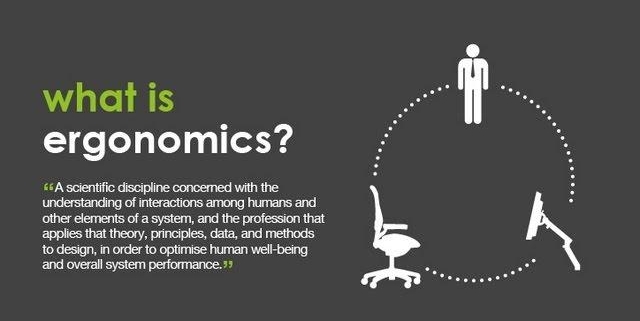
Ergonomics
Overview
Ergonomics, also known as human engineering or biotechnology, is a scientific discipline concerned with understanding the interactions of humans and other elements of a system to optimize the wellbeing and performance of individuals. The prevalence of ergonomic issues extends to every field, from office work to manufacturing, and even to leisure activities. By promoting a comfortable and safe working environment, ergonomics seeks to prevent a variety of musculoskeletal disorders and improve productivity and quality of life.
Types
Ergonomics is typically divided into three categories: physical, cognitive, and organizational ergonomics.
Physical Ergonomics is about human anatomical, physical, and biomechanical characteristics as they relate to physical activity. Key issues in this area include workplace layout, safety systems, handling materials, repetitive movements, and workstation design.
Cognitive Ergonomics is interested in mental processes, such as perception, memory, reasoning, and motor response, as these affect interactions among humans and others elements of a system. Examples may include mental workload, decision-making, human-computer interaction, human reliability, work stress and training.
Organizational Ergonomics is concerned with the optimization of sociotechnical systems, including their organizational structures, policies, and processes. Key areas include scheduling, work/rest schedules, team coordination, telecommunication, and cooperative work.
Causes
Ergonomic problems are commonly caused by repetitive movements, lack of movement variation, inadequate breaks, poor postures, vibration, cold temperatures, and stress. These factors can lead to wear and tear on the body, particularly on structures like nerves, muscles, and joints.
Symptoms
The common symptoms of ergonomic problems can vary widely, but often include discomfort, aches and pains, swelling, numbness, weakness, and decreased range of motion or flexibility. In severe cases, individuals may experience chronic pain or disability. These symptoms often develop gradually over time, so being aware of the early warning signs can help prevent more serious problems.
Diagnosis
Ergonomic problems can be diagnosed by a healthcare provider through a detailed examination of your lifestyle, work habits, physical activities, and symptoms. Mobile apps and other technology may also be used to monitor your posture and movements, looking for potential ergonomic problems. In some cases, doctors might refer patients to occupational therapists or ergonomists to obtain more detailed assessments and recommendations.
Treatment Options
There are several treatment options available for ergonomic problems. They usually involve a combination of physical changes (e.g., changing your workstation layout or equipment), lifestyle changes (e.g., regular breaks to stretch or move around, exercise, proper hydration), and sometimes medications to manage pain or inflammation. It’s crucial to remember that the most effective treatment is prevention by utilizing ergonomic principles in your work, home, and leisure activities.
Living With Ergonomics
Living with ergonomics means actively applying ergonomic principles in your daily activities. This may involve making changes to your work and home environments, learning proper techniques for lifting and carrying, and maintaining good health habits, like regular exercise, adequate rest, and good nutrition. Managing stress also plays a critical role in handling ergonomic problems.
When to Seek Help
If you begin to have persistent discomfort, pain, or other symptoms associated with your activities, it’s important to seek medical attention. Even if the symptoms seem minor, early intervention can prevent them from turning into a chronic problem. In some cases, it might be beneficial to consult with an occupational therapist or ergonomist who can provide personalized advice based on your specific circumstances. Don’t wait until your symptoms interfere with your ability to work or enjoy your normal activities — the sooner you address the problem, the better your outcome can be.
